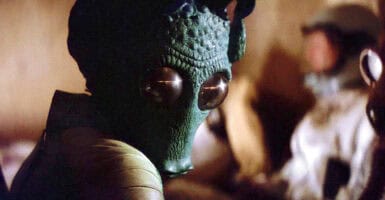Alfonso Cuarón Explains Why He’ll Never Make Another Movie Like Gravity Again
This article is more than 2 years old
“I’m a geek! I just don’t collect dolls.” Alfonso Cuarón’s Gravity opens in theaters in less than a week and a half. While the film is getting almost universal critical acclaim and early Academy Award buzz, the 51-year-old director could care less if the film wins any awards; he just wants people to watch the space epic in theaters. The above video is an in-depth, 33-minute video interview between Cuarón and film journalist David Poland. While 33 minutes seems like a lifetime on the Internet, the interview gives some great insights into Gravity and Cuarón’s impressive career.
The interview begins with how Gravity got started. Like most Hollywood movies, the film started with a screenplay. Cuarón wrote the film with his son Jonás over a three-week period in 2008. While the father and son originally thought the film was going to be a small movie, the pair soon realized that Gravity needed to be a much bigger project as they started to prep for it. Cuarón also believed that it wasn’t going to take too long to make, but then the financial crash happened in late 2008, which put the project on hiatus until they could figure out what to do next.
Cuarón took the finished script to his cinematographer Emmanuel Lubezki to plan how to shoot the film. In the past, Cuarón and Lubezki have been very meticulous with pre-production, so as to reduce any problems that would occur once a film started shooting. Gravity was no different, but Cuarón and Lubezki soon understood that the space epic was going to be a different beast to tame. Lubezki spent six months working with Cuarón and director James Cameron to build a special camera that would convey weightlessness on a sound stage.
Production on Gravity was split into two stages that took place during the summer in 2010 and 2011. One of the reasons why Cuarón split production was that special effects on the film took five long months to render, so if there was a problem during the first session, then they had a year to correct it for the second. In the interview, Cuarón explains that it was very frustrating making Gravity and he’s unlikely going to make another movie like it again. He also mentions one of the reasons to make a movie is to learn what to do right for the next one.
Gravity was set for release for November 2012, but it soon became clear it wasn’t going to be ready in time. Cuarón went to Warner Bros. to explain the delay, as the studio was prepared to give the Mexican director a few more months to smooth out the details. Instead, Cuarón asked for another year to complete Gravity, and the movie studio reluctantly agreed. In Warner Bros.’ eyes, they has already spent so much money to make the film, and Cuarón earned good faith with the success of Harry Potter and the Prisoner of Azkaban.
Lastly, Cuarón discusses the 3D process behind Gravity. Although the director likes the 3D technology, he thinks that it shouldn’t be used for every movie. He says 3D is a tool, just like a steadicam, a crane, or slow motion. It’s another way to convey a story for an audience and shouldn’t be used as an afterthought. Cuarón always envisioned Gravity as a 3D film and teases that the original title was Gravity: A Space Suspense in 3D. The title is quite charming if you ask me.
Gravity stars Sandra Bullock as Dr. Ryan Stone, a medical engineer on her first space shuttle mission, and George Clooney as Matt Kowalsky, a veteran astronaut on his final mission to space. When a horrific disaster occurs, Dr. Stone and Kowalsky are separated, and Stone is left to drift through space with no hope for rescue and with very little oxygen left in her tanks. The space epic will surely leave you breathless as well.
Gravity will hit theaters everywhere on October 4, in 3D and IMAX.












